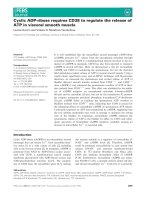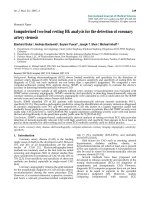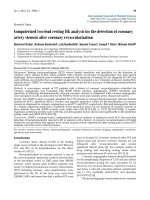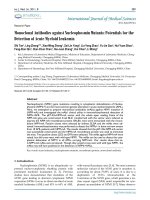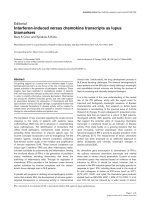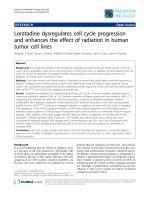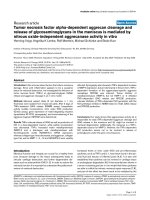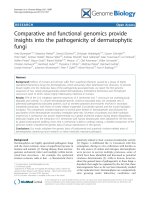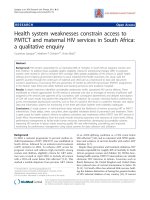Báo cáo y học: "Bispectral index versus COMFORT score to determine the level of sedation in paediatric intensive care unit patients: a prospective study" docx
Bạn đang xem bản rút gọn của tài liệu. Xem và tải ngay bản đầy đủ của tài liệu tại đây (289.77 KB, 9 trang )
Open Access
Available online />R9
February 2005 Vol 9 No 1
Research
Bispectral index versus COMFORT score to determine the level of
sedation in paediatric intensive care unit patients: a prospective
study
Andreas E Triltsch
1
, Grit Nestmann
1
, Helmut Orawa
1
, Maryam Moshirzadeh
1
, Michael Sander
1
,
Joachim Große
1
, Arka Genähr
1
, Wolfgang Konertz
2
and Claudia D Spies
3
1
Department of Anesthesiology and Intensive Care Medicine, Campus Benjamin Franklin, Charité University Hospital Berlin, Berlin, Germany
2
Professor of Cardiac Surgery, Department of Pediatrics, Campus Benjamin Franklin, Charité University Hospital Berlin, Berlin, Germany
3
Professor of Anesthesiology, Department of Medical Statistics and Clinical Epidemiology, Campus Benjamin Franklin, Charité University Hospital
Berlin, Berlin, Germany
Corresponding author: Claudia D Spies,
Abstract
Introduction Most clinicians give sedatives and analgesics according to their professional experience
and the patient's estimated need for sedation. However, this approach is prone to error. Inadequate
monitoring of sedation and analgesia may contribute to adverse outcomes and complications. With this
in mind, data obtained continuously using nonstimulating methods such as bispectral index (BIS) may
have benefits in comparison with clinical monitoring of sedation. The aim of this prospective
observational trial was to evaluate the use of electroencephalographic (EEG) BIS for monitoring
sedation in paediatric intensive care unit (PICU) patients.
Methods Forty paediatric patients (<18 years) were sedated for mechanical ventilation in a cardiac
surgical and general PICU. In each paediatric patient BIS and COMFORT score were obtained. The
study protocol did not influence ongoing PICU therapy. BIS and corresponding COMFORT score were
collected three times for each patient. Measurements with the best starting EEG impedances were
analyzed further. Deep sedation was defined as a COMFORT score between 8 and 16, and light
sedation as a score between 17 and 26. Biometric and physiological data, and Pediatric Risk of
Mortality III scores were also recorded.
Results There was a good correlation (Spearman's rho 0.651; P = 0.001) between BIS and
COMFORT score in the presence of deep sedation and low starting impedance. Receiver operating
characteristic (ROC) analysis revealed best discrimination between deep and light sedation at a BIS
level of 83.
Conclusion In the presence of deep sedation, BIS correlated satisfactorily with COMFORT score
results if low EEG impedances were guaranteed.
Keywords: bispectral index, electroencephalography, intensive care unit, paediatric, sedation
Introduction
Most paediatric intensive care unit (ICU) patients need seda-
tive and analgesic drugs during mechanical ventilation [1].
Sedatives and analgesics are given to improve comfort, to
reduce pain, to facilitate aggressive ICU therapy (i.e. mechan-
ical ventilation or insertion of intravascular lines) and to avoid
Received: 22 April 2004
Revisions requested: 28 May 2004
Revisions received: 15 September 2004
Accepted: 21 September 2004
Published: 10 November 2004
Critical Care 2005, 9:R9-R17 (DOI 10.1186/cc2977)
This article is online at: />© 2004 Triltsch et al., licensee BioMed Central Ltd.
This is an Open Access article distributed under the terms of the
Creative Commons Attribution License ( />licenses/by/2.0), which permits unrestricted use, distribution, and
reproduction in any medium, provided the original work is cited.
BIS = bispectral index; EEG = electroencephalography; ICU = intensive care unit; PICU = paediatric intensive care unit; ROC = receiver operating
characteristic; RSS = Ramsay Sedation Score.
Critical Care February 2005 Vol 9 No 1 Triltsch et al.
R10
accidental removal of medical devices. Most clinicians give
sedatives and analgesics according to their professional expe-
rience and the patient's estimated need for sedation. Inade-
quate monitoring of sedation and analgesia may contribute to
adverse outcomes and complications [2].
Only a few clinical scores have been validated for estimating
the level of sedation in paediatric ICU patients. The best eval-
uated score is the COMFORT score [3]. The COMFORT
score consists of eight categories and can evaluate a child's
behaviour and physiological responses to discomfort, fear and
pain in approximately 2 min. The COMFORT score is age inde-
pendent because age-adapted physiological parameters are
used. Apart from the examination of muscular tone, calculation
of the COMFORT score does not require any stimulation of
the patient. The COMFORT score can be divided into three
groups. A score of 8–16 points corresponds to deep seda-
tion, 17–26 indicates light sedation and 27–40 indicates inad-
equate sedation [4]. Common concerns about clinical
sedation scales are that the employed parameters are suscep-
tible to subjective interpretation and that information about the
level of sedation can only be obtained intermittently. Deeper
levels of sedation are difficult to assess using clinical sedation
scores. Sufficient information cannot be obtained regarding
over-sedation, which is associated with adverse outcomes,
prolonged ICU stay and increased costs [5-7]. Additionally,
patients treated with muscle relaxants cannot be evaluated
using clinical rating scores. In paediatric ICU patients, neu-
romuscular blocking agents are used in approximately 6–16%
of ventilatory support days [8]. A point of criticism regarding
the COMFORT score is that physiological parameters such as
haemodynamic indices and heart rate, which contribute to the
score (Table 1), can be influenced by ICU therapy. Therefore,
objective tools with which to measure the level of sedation are
urgently needed so that over-sedation can be avoided and the
level of sedation adjusted if muscle relaxants are given.
With this in mind, data obtained continuously using nonstimu-
lating methods such as bispectral index (BIS) may have bene-
fits in comparison with clinical monitoring of sedation. BIS is a
processed electroencephalographic (EEG) parameter that
provides a measure of sedative levels on a relative scale [9-
11]. For various agents (e.g. propofol and midazolam) it has
been shown that the BIS may correlate with dose-dependent
levels of anaesthesia [10,12-14] and ICU sedation [15-18].
Level of sedation and changes in memory function correlated
well with BIS in volunteers [19]. The BIS monitor was initially
designed to measure the level of consciousness in adults dur-
ing anaesthesia. In paediatric patients age-specific changes in
EEG activity could complicate interpretation of BIS measure-
ments [20]. Nevertheless, the first reports of use of BIS in pae-
diatric anaesthesia were promising [21-23]. Recently,
McDermott and coworkers [24] investigated the use of BIS
during sedation in children undergoing elective diagnostic or
therapeutic procedures. Those investigators found good cor-
relation between BIS and the University of Michigan Sedation
Scale. In a paediatric intensive care unit (PICU) setting, four
groups found a good to moderate correlation between BIS
and clinical scores [25-28]. Unfortunately, those studies used
clinical scores that have not been evaluated in paediatric
patients [25,27], the investigators were not sufficiently blinded
to the BIS results [25,26,28], or uncontrolled repeated meas-
urements in one patient were included in the study [25,27,28].
The objective of the present study was to evaluate use of the
BIS to monitor levels of sedation in paediatric ICU patients in
Table 1
The COMFORT scale
Alertness Calmness/
agitation
Respirator
response
Physical
movement
Blood pressure
(MAP)
Heart rate Muscle tone Facial
expression
Points
Deeply asleep Calm No coughing and
no spontaneous
respiration
No movement Below baseline Below baseline Totally relaxed; no
tone
Totally relaxed 1
Lightly asleep Slightly
anxious
Spontaneous
respiration with
little or no
response to
ventilation
Occasional, slight
movement
Consistently at
baseline
Consistently at
baseline
Reduced Normal; no
facial tension
evident
2
Drowsy Anxious Occasional cough
or resistance to
ventilator
Frequent, slight
movement
Infrequent
elevations of
15% or more
(1–3/observ.)
Infrequent
elevations of
15% or more
(1–3)
Normal Tension evident
in some facial
muscles
3
Fully awake
and alert
Very
anxious
Actively breathes
against respirator
or coughs
regularly
Vigorous
movement limited
to extremities
Frequent
elevations of
15% or more
(>3/observ.)
Frequent
elevations of
15% or more
(>3)
Increase tone and
flexion of fingers and
toes
Tension
evidence
throughout
facial muscles
4
Hyper alert Panicky Fights ventilator,
coughing or
choking
Vigorous
movement,
including torso and
head
Sustained
elevation ≥15%
Sustained
elevation ≥15%
Extreme muscle
rigidity and flexion of
fingers and toes
Facial muscles
contorting and
gromacing
5
MAP, mean arterial pressure. Data from Ambuel and coworkers [3].
Available online />R11
a blinded and prospective manner, and to compare it with use
of the COMFORT score. To avoid bias by repeating analysis
of data from the same patient, each patient was included only
once in the statistical analysis. In addition, we wished to focus
on the age of the children and on quality of EEG data.
Methods
Following agreement from the local ethics committee and
once informed consent from the legal guardians (parents) had
been obtained, we studied 50 paediatric patients admitted to
our PICU. All included patients met primary inclusion (age <18
years, requirement for mechanical ventilation) and exclusion
criteria (brain trauma, any kind of end-stage disease, use of
muscle relaxants or persistent postoperative relaxation
according to train-of-four monitoring, intractable agitation).
After enrolment patients were excluded if correct attachment
of electrodes was impossible, impedances did not comply
with the quality requirements of the manufacturer (<10 kΩ,
signal quality index >0.8, less than threefold deviation
between electrode impedances), or recording could not be
repeated at least twice. The sedation and/or analgesic regi-
mens were not controlled in the study and were administered
in accordance with standard operating procedures in the
PICU.
After PICU admission, the study was started when all examina-
tions on admission were completed and all sources of irritation
were eliminated. Electrodes were placed at F7, F8 and Fp (ref-
erence), and one electrode was placed beside Fp (ground) in
accordance with the international ten-twenty system [29].
Electrode sites were abraded using conventional alcohol
swabs. Paediatric silver–silver–chloride self-adhesive ECG
electrodes were applied (Blue Sensor Neonatal™ Medicotest,
Friedberg, Germany). An Aspect A-1000™ monitor (software
version 3.12; Aspect Medical Systems, Natick, MA, USA) was
used to compute the BIS. As recommended by the manufac-
turer, electrode impedances were kept below 10 kΩ, devia-
tions among electrode impedances less than threefold, and
signal quality index above 0.8.
Group assignment
Patients were assigned post hoc into groups according to
their level of sedation as measured using the COMFORT scale
(deep sedation, light sedation, inadequate sedation) and into
age groups (≤ 6 months and > 6 months of age). This age limit
was used because in children younger than 6 months old [30]
synchronization of the EEG is limited. Synchronization is
among the columns of the BIS algorithm [11].
Study protocol
The study protocol is summarized in Fig. 1. After PICU admis-
sion, the first recording was started immediately after all nec-
essary manipulations (examinations, laboratory specimens)
were completed. If the data were of good quality (see above),
then BIS values were sampled for 1 min and the median was
calculated. A second investigator, who was blinded to the BIS
results, assessed the patient clinically using the COMFORT
scale [3]. Every patient was assessed three times, with a min-
imal interval of 1 hour between measurements. The set with
the best impedance values was chosen for calculation of fur-
ther statistics. To interpret the significance of the data quality,
we also calculated the correlation between BIS and COM-
FORT score using the data couples with the poorest starting
impedances. For each patient the following were also
recorded: age, sex, medical diagnosis, Pediatric Risk of Mor-
tality III score [31], medications administered, blood gases and
temperature.
Statistical analysis
Correlations between the BIS and the COMFORT score were
calculated for each group using the Spearman's rank order
correlation coefficient. Because BIS and COMFORT score
were classified on an ordinal scale, regression analysis and
confidence intervals could not be calculated. Therefore, we
calculated the coefficient of determination (r
2
).
The ability of BIS to discriminate between sedation levels as
classified using the COMFORT scale was tested using
'receiver operating characteristic' (ROC) statistics. The cut-off
point was determined at the point of greatest sensitivity and
specificity for discrimination. A logistic regression model using
the BIS was developed to predict sedation levels of the
patients (deep versus light sedation) in accordance with the
COMFORT classification.
Data are expressed as mean ± standard deviation in the case
of a normal distribution and interval scaling level, and as
median (range) if the data were not distributed normally or in
Figure 1
Study designStudy design. BIS, bispectral index; PICU, paediatric intensive care
unit.
Critical Care February 2005 Vol 9 No 1 Triltsch et al.
R12
case of ordinal scaling level. The χ
2
and Fisher's exact tests
were used to analyze categorical data and Mann–Whitney U-
test for data on at least ordinal level. Data analysis was per-
formed using SPSS statistical software (version 8.0; SPSS
Inc., Chicago, IL, USA) and Microsoft Excel with Analyze It™
(version 1.48; Analyze-it Software Ltd, Leeds, UK)
modification.
Results
A total of 53 paediatric intensive care patients met our primary
inclusion criteria. Three patients were excluded because of
inability to achieve lead impedances with less than threefold
deviance with the first set. In 10 patients recording could not
be repeated at least twice because extubation was performed
during the period of study. Finally, we enrolled 40 PICU
patients into the study. According to COMFORT scoring no
child was inadequately sedated, resulting in two COMFORT
groups (i.e. deep sedation and light sedation). Patient charac-
teristics are presented in Table 2. On comparing the sedation
groups, we found that the parameters diagnosis (P = 0.162),
Pediatric Risk of Mortality III score (P = 0.891), sex (P =
0.770) and age (P = 0.716) did not differ significantly
between groups. We also found no significant differences in
arterial carbon dioxide tension (P = 0.750), body temperature
(P = 0.879) and type of medication (benzodiazepines, P >
0.99; opioids, P = 0.650; propofol, P = 0.286; ketamine, P >
0.99).
For those data couples with the best impedance levels (3.3 ±
1.8 kΩ, range 0.3–7.8 kΩ), BIS and COMFORT score
correlated significantly for all patients (n = 40, P = 0.001;
Spearman's rho: r = 0.651, r
2
= 0.42; Fig. 2) and for patients
without ketamine (n = 38, P = 0.001; Spearman's rho: r =
0.668; r
2
= 0.45). The correlation between BIS and COM-
FORT for data couples with the worst impedances (5.1 ± 2.2
kΩ, range 1.9–9.9 kΩ) was poor (P = 0.05; Spearman's rho:
r = 0.387, r
2
= 0.15). All further results reported are for the
data couples with the best impedance levels.
Our results showed a significant correlation (n = 29, P =
0.003; Spearman's rho: r = 0.525, r
2
= 0.28) for deeply
sedated patients (COMFORT score 8–16) and for patients
who had not received ketamine (n = 27, P = 0.002; Spear-
man's rho: r = 0.565, r
2
= 0.32) whereas no correlation was
found in the group with light sedation (COMFORT score 17–
26; n = 11, P = 0.956; Spearman's rho: r = 0.019, r
2
< 0.01).
Table 2
Patient characteristics
Characteristic/parameter All patients Deeply sedated Lightly sedated P
Number 40 29 11 -
Age (median [range]) 5.6 months (21 days–16 years) 5.7 months (1.5 months–13 years) 5.1 months (21 days–16 years) 0.716
Sex (n[%])
Male 21 (52) 16 (55) 5 (45) 0.770
Female 19 (47) 13 (45) 6 (55)
Diagnosis (n[%])
Cardiac 34 (85) 23 (79) 11 (100) 0.162
Gastrointestinal 2 (5) 2 (7) 0 (0)
Other 4 (10) 4 (14) 0 (0)
PRISM III score (mean ±
SD)
7.22 ± 5.29 7.34 ± 5.78 6.91 ± 3.96 0.891
Medication (n[%])
Benzodiazepines 34 (85) 25 (86) 9 (82) ≥ 0.999
Opioids 33 (83) 23 (79) 10 (91) 0.650
Propofol 13 (32) 11 (38) 2 (18) 0.286
Ketamine 2 (5) 2 (7) 0 (0) ≥ 0.999
PaCO
2
(kPa; mean ±
SD)
5.1 ± 0.8 5.1 ± 0.9 4.9 ± 0.8 0.750
Temperature (°C; mean
± SD)
37.4 ± 0.7 37.4 ± 0.6 37.4 ± 0.7 0.879
P values are given for the comparison of deeply sedated versus lightly sedated. PRISM, Pediatric Risk of Mortality III score, PaCO
2
, arterial carbon
dioxide tension; SD, standard deviation;
Available online />R13
ROC analysis identified the BIS index level that distinguished
best between deep and light sedation (groups classified by
COMFORT scores). The calculated cut-off point between the
groups was at a BIS of 83, which had a sensitivity of 75.9%
and a specificity of 81.8% (area under the curve 0.834, 95%
confidence interval 0.699–0.968; Fig. 3).
The logistic regression model using BIS as an explanatory var-
iable was able to predict sedation according to COMFORT
score correctly for 80% of the children. This total percentage
is derived from correct predictions in 90% of deeply sedated
patients (COMFORT score <17, n = 29) and in 55% of lightly
sedated patients (COMFORT score 17–26, n = 11).
In patients younger than 6 months (n = 21, range 0.7–5.7
months) BIS and COMFORT score correlated significantly
better (P < 0.001 in the younger group versus P = 0.041 in
the older group; n = 19, range 6.3 months–16 years) and with
a higher correlation coefficient (Spearman's rho: in younger
patients r = 0.781, r
2
= 0.61 versus in older children r = 0.473,
r
2
= 0.22; Fig. 4).
The correlation was slightly better in older children when the
two patients who had received ketamine were excluded from
the analysis (Spearman's rho: n = 17, P = 0.030; r = 0.527, r
2
= 0.28).
Discussion
Most sedation scoring systems use responses to stimuli [32]
and/or patient appearance and physiological variables [3] to
estimate the level of sedation. These scores must be inter-
preted subjectively or, in case of physiological parameters, can
be influenced by ICU therapy. In contrast to clinical scoring
systems, the BIS system generates information continuously
and objectively. The BIS monitor was developed to assess
intraoperative depth of anaesthesia and to avoid awareness in
adults. Data from studies that were not blinded sufficiently
[25,26,28] or that employed scores that have not been evalu-
ated in the PICU setting [25,27] suggested a moderate corre-
lation between BIS and clinical scoring systems.
The aim of this prospective, blinded study was to determine
whether BIS is a useful tool for assessing the level of sedation
in critically ill paediatric patients. For statistical calculation only
one data set (BIS versus COMFORT score) per patient was
evaluated. Therefore, bias introduced by including multiple
observations from one patient was avoided. In the study we
compared BIS with the COMFORT score, which was previ-
ously validated in the PICU setting [3,4]. The study indicated
that there was a moderate correlation between BIS and corre-
sponding COMFORT scores (r
2
= 0.42). Subanalysis revealed
a distinctly better coefficient of determination during deep
sedation (r
2
= 0.28) than with light sedation (r
2
< 0.01) for the
assessment tools. This was confirmed by the binary logistic
regression findings, which revealed a good ability of BIS to
predict deep levels of sedation (90%). According to COM-
FORT score, BIS could predict this level among lightly
sedated children in only 55% of the cases. The overall per-
centage of correct prediction was 80%. Using ROC analysis
we found a BIS value of 83 to distinguish best between light
and deep sedation as assessed using the COMFORT score.
Figure 2
Correlation of bispectral index (BIS) and COMFORT score at different levels of sedationCorrelation of bispectral index (BIS) and COMFORT score at different
levels of sedation.
Comfort Score
28242016128
Bispectral Index
100
80
60
40
20
0
lowess curve
light sedation
COMFORT 17–26
deep sedation
COMFORT 8–16
Figure 3
Receiver operating characteristic (ROC) analysis: cut-off point between light and deep sedationReceiver operating characteristic (ROC) analysis: cut-off point between
light and deep sedation. BIS, bispectral index.
No discrimination
BIS
1 – specificity (false positives)
0 0.2 0.4 0.6 0.8 1.0
1.0
0.9
0.8
0.7
0.6
0.5
0.4
0.3
0.2
0.1
0
Sensitivity (true positives)
BIS 83
Critical Care February 2005 Vol 9 No 1 Triltsch et al.
R14
Probably because of the exclusion of agitated children, we did
not observe under-sedation in the study. We were therefore
unable to differentiate further between lightly sedated and
under-sedated children. This could be interpreted as an inves-
tigational bias. Furthermore, poor EEG data quality could
cause a large number of movement artifacts, resulting in low
signal quality, and we cannot exclude the possibility that move-
ment artifacts contributed to the lower coefficient of determi-
nation for lighter sedated children than for children under
deeper sedation. This was reported in adult settings [33,34].
Our data support the findings of previous studies [25-28].
Berkenbosch and colleagues [25] compared BIS with three
simultaneously measured clinical sedation scores (Ramsay
Sedation Score [RSS], Tracheal Suctioning Score, and Pedi-
atric Intensive Care Unit Sedation Score) in paediatric patients
(age 5.7 ± 6.1 years, range 1 month–20 years). None of the
studied scores was clinically validated for use in paediatric
ICU patients. The BIS monitor correlated moderately with clin-
ically assessed sedation levels (r
2
= 0.12, 0.08 and 0.21,
respectively). BIS was found to differentiate reliably between
adequate and inadequate sedation (cut-off BIS 70), but it was
relatively insensitive in differentiating between adequate and
over-sedation (cut-off BIS 50). Critical aspects in the study
conducted by Berkenbosch and coworkers are that different
individuals performed the sedation assessments, which might
have resulted in considerable interobserver variability. The
nurses assessing the level of sedation were not formally
blinded to the BIS results. Multiple sets of data derived from
single patients were included in same analysis, which might
have influenced the results. Twenty-four patients were
included in the study, but measurements were repeated 18 ±
14 times per patient.
Crain and colleagues [26] also used the COMFORT score to
estimate the level of sedation. Those investigators studied 31
patients (age 53 ± 11 months, median 25 months; no range
presented) and selected each patient's lowest and highest
BIS measurement for further investigation. The direct coeffi-
cient of determination between BIS and COMFORT score
was only moderate (r
2
= 0.26), which reflected their finding
that some patients exhibited good correlation whereas others
did not. After grouping BIS results into four levels of sedation,
a high coefficient of determination (r
2
= 0.89) with the COM-
FORT score resulted. Grouping of BIS values was conducted
according to results formerly derived from adult data, but it is
not proven whether this procedure is appropriate in children.
Aneja and coworkers [27] studied 24 patients without neu-
romuscular blockade, comparing BIS with RSS. They found a
high and significant coefficient of determination (r
2
= 0.77; age
6.3 ± 2.9 years, range 1–16 years). The calculated cut-off
point for distinguishing between over-sedation (RSS 6) and
comfortable sedation (RSS 2–5) by ROC analysis was a BIS
level of 42. Under-sedation (RSS 1) was found at a BIS level
in excess of 76. Another component of that study dealt with
patients receiving neuromuscular blockade (age 8.4 ± 3.7
years, range 0.5–19 years). According to BIS, the authors
observed a significant number of patients suffering from inad-
equate sedation, which would not have been detectable by
clinical investigation. Limitations of the study were the
inclusion of multiple observations per patient and that the RSS
has not been validated for use in paediatric patients, as men-
tioned above.
Courtman and coworkers [28] recently compared BIS and
COMFORT score in critically ill children (mean age 3.9 ± 4.5
years). Those investigators found a moderate coefficient of
determination (r
2
= 0.26) between BIS and COMFORT score
in 25 neurologically normal children and a weak coefficient of
determination (r
2
= 0.06) in 15 children who were classified as
being neurologically abnormal. In that study BIS could discrim-
inate between light and deep levels of sedation. In conform-
ance with the findings of Berkenbosch and coworkers [25],
Courtman and colleagues found that BIS was unable to dis-
criminate between deep and very deep levels of sedation. The
significance of this study is also limited by the inclusion of mul-
tiple observations per patient.
In our study the quality of EEG impedance appeared to have a
major impact on correlation between BIS and COMFORT
score. Although within the limits recommended by the manu-
facturer, we found only a low coefficient of determination (r
2
=
0.15) between COMFORT score and corresponding BIS in
case of higher impedances (5.1 ± 2.2 kΩ). This emphasizes
the importance of good data quality. On the basis of our expe-
Figure 4
Correlation of bispectral index (BIS) and COMFORT score in patients younger and older than 6 monthsCorrelation of bispectral index (BIS) and COMFORT score in patients
younger and older than 6 months.
COMFORT
30282624222018161412108
BIS
100
80
60
40
20
0
Age
≥6months
<6
months
Available online />R15
rience, we would advise use of impedance values of less than
5 kΩ.
Unexpectedly, correlation between the methods was better in
children younger than 6 months. Patient basic data do not
explain this finding. The impact of age on BIS is still debated,
with divergent findings reported in the anaesthesia literature
[21,35]. Davidson and coworkers [35] compared BIS with the
corresponding consciousness level during emergence from
anaesthesia in a prospective, blinded manner in children (≥1
year old) and infants (<1 year old) undergoing elective circum-
cision. BIS increased significantly as sevoflurane concentra-
tions decreased in children, but a similar relationship was not
demonstrated in infants. Adult EEG sensors were used in that
study for all patients, which could partly account for the differ-
ence in findings between that study and ours. There are no
additional data in the paediatric ICU literature.
Because different scoring systems are used for clinical estima-
tion of the level of sedation, it is difficult to compare our find-
ings with those of other investigators. The end-points of
sedation are neither defined consistently nor comparable
between the studies mentioned above. In our study COM-
FORT scores corresponded to a wide range of BIS values. In
other words, the BIS index does not always reflect the
expected clinical/subjective level of sedation. This observation
is in agreement with the experience of other groups who com-
pared neurophysiological parameters (i.e. BIS, somatosensory
evoked magnetic fields, evoked potentials) with clinical seda-
tion scores in adult patients [36-38] and with the other paedi-
atric ICU studies [25-28]. This could be related to the fact that
neurophysiological parameters and clinical sedation scores
measure different attributes. BIS automatically matches cer-
tain EEG patterns to clinical states that are found in adult vol-
unteers under sedation or anaesthesia. In contrast, clinical
scores are used to summarize the investigator's impression of
whether the patient is comfortable in the ICU setting. An
extreme example would be the patient who is awake with a
high BIS score but who appears to be completely comfortable.
The limitations of clinical scores in estimating the level of seda-
tion have been discussed broadly [32]. In addition to these lim-
itations, in the case of the COMFORT score there is a specific
limitation caused by the inclusion of physiological data (heart
rate and blood pressure). When physiological parameters are
used in a heterogeneous population such as paediatric ICU
patients, it is difficult to define reference data. If changes in
physiological parameters caused by sedatives are to be inter-
preted, then a standardized sedation regimen and co-medica-
tion are needed. In our opinion this is not the case in the ICU
setting. The majority of children included in the present study
were postoperative cardiac surgical patients. Most of them
had reduced cardiac function and required catecholamines. In
this group of patients in particular, haemodynamic variability
could not be attributed solely to sedative drugs.
The COMFORT score cannot distinguish between very deep
stages of sedation, whereas with neurophysiological methods
such as the BIS this might be possible. EEG measurements
often fail to provide correct values with very light or absent
sedation because motor activity and skeletal muscle tone
increase. However, this situation will never fall within the
domain of electrophysiological monitoring because clinical
estimation will be sufficient in unsedated or only lightly
sedated patients in the ICU setting.
Data from the investigations cited above and our data suggest
that the BIS monitor might be useful in the case of moderate
to deep levels of sedation. Our group found that BIS levels
below 83 had good correlation with clinical estimation.
Berkenbosch and coworkers [25] suggested that a moderate
level of sedation could be achieved at BIS values between 50
and 70, and deep sedation at levels below 50. This corre-
sponds well with the data presented by Aneja and coworkers
[27], who found that a BIS above 76 indicated inadequate,
light sedation and that a BIS below 46 marked very deep
sedation or over-sedation. Whether BIS can detect over-seda-
tion remains controversial. Berkenbosch and coworkers [25]
and Courtman and colleagues [28] found that BIS could not
discriminate between deep and very deep levels of sedation.
In our opinion, this finding could indicate that clinical scores
are not useful for identifying very deep levels of sedation.
Few data exist for paralyzed PICU patients. In this situation
clinical scores are not applicable because they need muscular
activity to be present to rate the level of sedation. Aneja and
coworkers [27] stated that the RSS and bedside nurse
assessments are inadequate for monitoring the depth of seda-
tion in paralyzed children, and concluded that BIS is a useful
adjunct for assessing sedation in paralyzed patients. In our
opinion use of electrophysiological monitoring tools such as
the BIS is imperative in paralyzed patients to prevent levels of
sedation that are too light or too deep.
Furthermore, the terms 'under-sedation' and 'over-sedation'
should be used carefully because the level of sedation
required depends on the individual patient's needs. Bearing
this in mind, clinician should adapt the level of sedation to the
demand of the patient. When deeper levels of sedation are
needed, BIS can help by avoiding undesired levels of sedation.
In situations when muscular paralysis is necessary, BIS could
make a valuable contribution because established clinical
tools fail to measure the level of sedation in this setting.
Conclusion
Our data indicate that an impedance level below 5 kΩ is
needed for valid interpretation of BIS values in PICUs. At such
impedance levels the BIS index correlates well with the COM-
FORT sedation score, in particular in children with deeper lev-
els of sedation. Discrimination between light and moderate
sedation with high sensitivity and specificity was possible at a
Critical Care February 2005 Vol 9 No 1 Triltsch et al.
R16
BIS level of 83. The BIS monitor provides continuous meas-
urements of the level of sedation without having an impact on
patient comfort. It may be a useful adjunct in clinical routine
and may be especially helpful in certain situations when clini-
cal estimation fails (e.g. if muscular paralysis is necessary).
Competing interests
The author(s) declare that they have no competing interests.
Authors' contributions
All authors contributed to the design, conduct, analysis and
interpretation of the research reported. CS and WK were prin-
cipal investigators and led the conceptual design of the study.
MS and GN assisted with data collection and analysis, and
with manuscript preparation.
Acknowledgements
We would like to thank Prof. Gaedicke (Department of Pediatrics, Cam-
pus Charité Mitte Universitätsmedizin Berlin) for his help with the prep-
aration of the manuscript.
References
1. Tobias JD: Tolerance, withdrawal, and physical dependency
after long-term sedation and analgesia of children in pediatric
intensive care unit. Crit Care Med 2000, 28:2122-2132.
2. Selbst SM: Adverse sedation events in pediatrics: a critical
incident analysis of contributing factors. Pediatrics 2000,
105:864-865.
3. Ambuel B, Hamlett KW, Marx CM, Blumer JL: Assessing distress
in pediatric intensive care environments: the COMFORT scale.
J Pediatr Psychol 1992, 17:95-109.
4. Marx CM, Smith PG, Lowrie LH, Hamlett KW, Ambuel B, Yamash-
ita TS, Blumer JL: Optimal sedation of mechanically ventilated
pediatric critical care patients. Crit Care Med 1994,
22:163-170.
5. Burns AM, Shelly MP, Park GR: The use of sedative agents in
critically ill patients. Drugs 1992, 43:507-515.
6. Durbin CG Jr: Sedation in the critically ill patient. New Horiz
1994, 2:64-74.
7. Kollef MH, Levy NT, Ahrens TS, Schaiff R, Prentice D, Sherman G:
The use of continuous i.v. sedation is associated with prolon-
gation of mechanical ventilation. Chest 1998, 114:541-548.
8. Martin LD, Bratton SL, Quint P, Mayock DE: Prospective docu-
mentation of sedative, analgesic, and neuromuscular blocking
agent use in infants and children in the intensive care unit: a
multicenter perspective. Pediatr Crit Care Med 2001,
2:205-210.
9. Sigl JC, Chamoun NG: An introduction to bispectral analysis for
the electroencephalogram. J Clin Monit 1994, 10:392-404.
10. Glass PS, Bloom M, Kearse L, Rosow C, Sebal P, Manberg P: Bis-
pectral analysis measures sedation and memory effects of
propofol, midazolam, isoflurane, and alfentanil in healthy
volunteers. Anesthesiology 1997, 86:836-847.
11. Rampil IJ: A primer for EEG signal processing in anesthesia.
Anesthesiology 1998, 89:980-1002.
12. Liu J, Singh H, White PF: Electroencephalogram bispectral
analysis predicts the depth of midazolam-induced sedation.
Anesthesiology 1996, 84:64-69.
13. Liu J, Singh H, White PF: Electroencephalographic bispectral
analysis correlates with intraoperative recall and depth of pro-
pofol-induced sedation. Anesth Analg 1997, 84:185-189.
14. Doi M, Gajraj RJ, Mantzaridis H, Kenny GNC: Relationship
between calculated blood concentrations of propofol and
electrophysiological variables during emergence from anaes-
thesia: comparison of bispectral index, spectral edge fre-
quency, median frequency and auditory evoked potentials. Br
J Anaesth 1997, 78:180-184.
15. De Deyne C, Struys M, Decruyenaere J, Creupelandt J, Hoste E,
Colardyn F: Use of continuous bispectral EEG monitoring to
assess depth of sedation in ICU patients. Intensive Care Med
1998, 24:1294-1298.
16. Simmons LE, Riker RR, Prato BS, Fraser GL: Assessing sedation
during intensive care unit mechanical ventilation with the bis-
pectral index and the Sedation–Agitation Scale. Crit Care Med
1999, 27:1499-1504.
17. Shapiro BA: Bispectral index: better information for sedation in
the intensive care unit? Crit Care Med 1999, 27:1663-1664.
18. Triltsch AE, Welte M, von Homeyer P, Grosse J, Genahr A,
Moshirzadeh M, Sidiropoulos A, Konertz W, Kox WJ, Spies CD:
Bispectral index-guided sedation with dexmedetomidine in
intensive care: a prospective, randomized, double blind, pla-
cebo-controlled phase II study. Crit Care Med 2002,
30:1007-1014.
19. Iselin-Chaves IA, Flaishon R, Sebel PS, Howell S, Gan TJ, Sigl J,
Ginsberg B, Glass PS: The effect of the interaction of propofol
and alfentanil on recall, loss of consciousness, and the bispec-
tral index. Anesth Analg 1998, 87:949-955.
20. Werry C, Neulinger A, Eckert O, Lehmkuhl P, Pichlmayr I: [Age-
related correlation between EEG parameters and depth of
anesthesia under propofol. Effect of fentanyl]. Anaesthesist
1996, 45:722-730.
21. Denman W, Swanson EL, Rosow D, Ezbicki K, Connors PD,
Rosow CE: Pediatric evaluation of the bispectral index (BIS)
monitor and correlation of BIS with end-tidal sevoflurane con-
centration in infants and children. Anesth Analg 2000,
90:872-877.
22. Laussen PC, McGowan FX, Sullivan LJ, Murphy JA: Bispectral
index monitoring in children during mild hypothermic cardiop-
ulmonary bypass [abstract]. Anesthesiology 1998, 89:A925.
23. Johansen JW: Continuous intraoperative bispectral index mon-
itoring and perioperative outcome in children [abstract].
Anesth Analg 1998, 86:S406.
24. McDermott NB, VanSickle T, Motas D, Friesen RH: Validation of
bispectral index monitor during conscious sedation and deep
sedation in children. Anesth Analg 2003, 97:39-43.
25. Berkenbosch JW, Fichter CR, Tobias JT: The correlation of the
bispectral index monitor with clinical sedation scores during
mechanical ventilation in the pediatric intensive care unit.
Anesth Analg 2002, 94:506-511.
26. Crain N, Slonim A, Pollack MM: Assessing sedation in the pedi-
atric intensive care unit by using BIS and the COMFORT scale.
Pediatr Crit Care Med 2002, 3:11-14.
27. Aneja R, Heard AM, Fletcher JE, Heard CM: Sedation monitoring
of children by the Bispectral Index in the pediatric intensive
care unit. Pediatr Crit Care Med 2003, 4:60-64.
28. Courtman SP, Wardurgh A, Petros AJ: Comparison of the bis-
pectral index monitor with the Comfort score in assessing
level of sedation in critically ill children. Intensive Care Med
2003, 29:2239-2246.
Key messages
• In daily clinical practice of paediatric ICU therapy, the
BIS monitor provides continuous measurements of
sedation level without having an impact on the patient's
comfort.
• In certain situations when clinical estimations fail (i.e. if
muscular paralysis is necessary), electrophysiological
monitoring tools such as BIS should be considered
imperative to prevent inadequately light or inadequately
deep sedation.
• In the case of deep sedation, BIS correlated satisfac-
tory with the COMFORT score results if low EEG
impedances were guaranteed.
Available online />R17
29. Electrode Position Nomenclature Committee: American Electro-
encephalographic Society guidelines for standard electrode
position nomenclature. J Clin Neurophysiol 1991, 8:200-202.
30. Schmid RG: The normal development of the EEG from
neonates to adults in subjects with open eyes. Clinical Electro-
encephalography in Infancy and Adolescence [in German] Berlin:
Springer; 1995:55-79.
31. Pollack MM, Patel KM, Ruttiman UE: PRISM III: an updated Pedi-
atric Risk of Mortality score. Crit Care Med 1996, 24:743-752.
32. De Jonghe B, Cook D, Appere-De-Vecchi C, Guyatt G, Meade M,
Outin H: Using and understanding sedation scoring systems:
a systematic review. Intensive Care Med 2000, 26:275-285.
33. Nasraway SA Jr, Wu EC, Kelleher RM, Yasuda CM, Donally AM:
How reliable is the bispectral index in critically ill patients? A
prospective, comparative, single-blinded observer study. Crit
Care Med 2002, 30:1483-1487.
34. Bruhn J, Bouillon TW, Shafer SL: Electromyographic activity
falsely elevates the bispectral index. Anesthesiology 2000,
92:1485-1487.
35. Davidson AJ, McCann ME, Devavaram P, Auble SA, Sullivan LJ,
Gillis JM, Laussen PC: The differences in bispectral index
between infants and children during emergence from
anesthesia after circumcision surgery. Anesth Analg 2001,
93:326-330.
36. Schulte-Tamburen AM, Scheier J, Briegel J, Schwender D, Peter K:
Comparison of five sedation scoring systems by means of
auditory evoked potentials. Intensive Care Med 1999,
25:377-382.
37. Ibrahim AE, Taraday JK, Kharasch ED: Bispectral index monitor-
ing during sedation with sevoflurane, midazolam and propoful.
Anesthesiology 2001, 95:1151-1159.
38. Frenzel D, Greim CA, Sommer C, Bauerle K, Roewer N: Is the bis-
pectral index appropriate for monitoring the sedation level of
mechanically ventilated surgical ICU patients? Intensive Care
Med 2002, 28:178-183.
